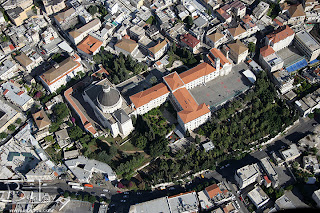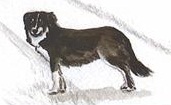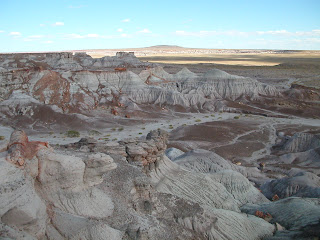Sheepdog's Round-up
The Nazareth of Yesterday and Today
 |
| Located in Nazareth Village, this building typifies 1st century dwellings. | |
We’ve all heard of Nazareth, the place where Joseph and Mary raised Jesus, but it seems there are those who like to point out that it never existed, neither before nor during the life of Jesus. I thought this would be an easy article to write, but I came across a lot of negative articles that scoff the validity of the Gospel writers, and some are outright nasty in their comments. I just took it for granted that everyone, like myself, accepted there was a real Nazareth in the time of Jesus. In defence of the ancient town, there has not been one ancient document brought to light where it is written: “Those Christians are untruthful in that the place they call Nazareth does not exist.” So the skeptics are of the modern species. One of these skeptics, Frank Zindler, compares Nazareth to the fictional land of OZ, where Dorothy and Toto skipped down the yellow-brick road! After learning of such skepticism, I decided to do more digging because I believe what it says in the New Testament – no reason to doubt it – so I wanted to see what evidence exists today - you see, you will find Nazareth on every modern day map of Israel, but what connection does this place have to the Nazareth of the first century?
 |
| View across Nazareth taken in 1910 |
John McRay, PH.D, author of Archaeology and the New Testament, is quoted by Lee Strobel in his book The Case for Christ, as saying about Nazareth, “There has been discussion about some sites from the first century, such as exactly where Jesus’ tomb is situated, but among archaeologists there has never really been a big doubt about the location of Nazareth. The burden of proof aught to be on those who dispute its existence.” Even archaeologists seem to be in agreement. Let’s have a look at what is written about Nazareth.
 |
| 1862 - looking south-east over Nazareth |

NAZARETH IN THE NEW TESTAMENT
Luke 4:16, He went to Nazareth, where he had been brought up, and on the Sabbath day he went into the synagogue, as was his custom. And he stood up to read. (Jesus had been teaching in Galilee and was now returned home)
John 1:46, Nathanial is quoted as saying to Philip, “Can any good thing come out of Nazareth?” This he said after Philip had said to him, “We have found him, of whom Moses in the law, and the prophets, did write, Jesus of Nazareth, the son of Joseph.”
Indeed, Nathanial makes it sound as if Nazareth was a small and insignificant place on the “wrong side of the tracks”, but what I like is that he sounds so sure of the town’s existence.
Luke 1:26 And in the sixth month the angel Gabriel was sent from God unto a city of Galilee, named Nazareth.
Luke 4:39 When Joseph and Mary had done everything required by the Law of the Lord, they returned to Galilee to their own town of Nazareth.
(Luke 4:39) When they got home, Jesus was found to be missing, but after returning to Jerusalem his parents found him. Luke 4:51 Then he (Jesus) went down to Nazareth with them and was obedient to them.
Also see Matthew 2:23; 4:13; 21:11; 26:71
Mark 1:9; 1:24; 10:47; 14:67; 16:6
Luke 2:4; 2:39; 2:51; 4:34; 18:37; 24:19
John 1:45; 18:5; 18:7; 19:19
Acts 2:22; 3:6; 4:10; 6:14; 10:38; 22:80; 26;90
According to Wikipedia, you will find Jesus of Nazareth mentioned in English translations of the New Testament seventeen times. There are variances in the translations, so in the original Greek it is “Jesus the Nazarene” or “Jesus the Nazorean”. A standard King James version of the New Testament mentions “Nazareth” twenty-nine times, but in surviving Greek manuscripts it is only mentioned twelve times, where it appears in different forms: Nazora, Nazareth, Nazaret, Nazarath. These differences are a result from the English references being translated from the Greek adjective nazarenes, “of Nazareth”, but they still confirm that Jesus came from the place known as Nazareth. In Strong's Exhaustive Condordance of the Bible, under Nazareth you will find 29 listings, all of which I have included in this article.
Skeptics use these variations to validate their argument that there was no place during Jesus’ lifetime ever called Nazareth and that the town appeared only after his death, perhaps even a few centuries later.
OTHER ANCIENT WRITINGS
The earliest non-scriptural reference to Nazareth is a citation by the historian Sextus Julianus Africanus, dated at about A.D. 200. Born c. A.D. 160 - c.240, Africanus was a Christian traveller and historian.
Eusebius, a Roman historian and Bishop of Caesarea (c. A.D. 263 - 339), wrote in his Onomasticon (directory of place names found in the Scriptures, written A.D. 324 - 339) that Nazareth was about fifteen milestones from Legio, that was an eastern journey from Legio to Tabor, or about fifteen Roman miles.
Jewish historian Josephus (Joseph ben Matthias, born A.D. 37) mentioned Jesus two times in his book Antiquities, but he neglected to mention Nazareth. And Nazareth is neither mentioned in the Talmud nor in any writings by the apostle Paul. Skeptics like to point out that with Nazareth not being mentioned in these other ancient writings, that it couldn’t have existed until well after the first century. Were the Gospel writers wrong in this but correct in everything else they wrote about? We must remember that every single important ancient document ever written, and that includes maps and letters, did not survive the past centuries of fires and warfare, and that only a percentage of them survive to this day.
The pilgrim Arculf recorded in the year 680, in his travels, that Nazareth had two existing churches. One, he recorded, was at Mary’s spring, and the other was on the traditional site of the Annunciation (Mary‘s encounter with the angel Gabriel), where the basilica stands today. Archaeological remains of pre-Christian origin were uncovered beneath the Church of the Annunciation, located on the traditional site of Joseph and Mary’s house, in 1955: evidence that people did dwell there before or least by Jesus’ time.
NAME ORIGIN
What of the origin of the name Nazareth? Does it mean “branch”? Yes, Nazareth’s root word is netser; it means branch, or descendant, and is derived from natsar (see Strong’s Concordance Hebrew 5341/5342). In Isaiah 11, the coming Messiah is prophesied as coming from the branch of Jesse. However, do not confuse Nazareth with Nazarite, or Nazarites, as mentioned in Numbers and Judges (books in the Old Testament), as they differ in meaning.
THE NAZARETH THAT JESUS KNEW
His hometown of Nazareth lay just 1.5 miles north of the road that led to Jerusalem and Egypt. His village was near the Plain of Esdralon and was situated in Galilee, a Roman province set in hills referred to as “the south ridges of Lebanon”. To the east was the Sea of Galilee, and to the west was the Mediterranean Sea. Just one mile south of Nazareth was Japha, which according to the historian Josephus was the “largest village in Galilee”. North of Nazareth was Cana, where Jesus attended a wedding, and due to a shortage of wine there, he turned six pots of water into wine, and not just any wine, but the best wine to be had! (John 2: 6-11)
How many times did he climb Precipice Mountain? At a distance of about a mile and a half from Nazareth, the steep hill, rising 500 feet above the town, has a steep precipice, where its foot lay the Roman road called the Via Maris (Way of the Sea), which connected the ancient city of Damascus with the Mediterranean seaports in the west. From atop Mount Precipice he would have seen breathtaking views - seeing a good part of Galilee and committing it to memory before he ever began his travelling ministry. Here, according to tradition, he once had a frightening experience (Luke 4:29-30) when Nazareth’s people “thrust” him out of the synagogue and “led him to the brow of the hill” with the intent to kill him. Mary, his mother, greatly frightened for her son’s life, witnessed this violent act from another hill north of Mount Precipice. But there seems to be some confusion over exactly which hill this happened on, because, as you read further down about the chapel Our Lady of Fright near the end of this Nazareth article, there is another hill (one that the ruins of the chapel sit on) that people also say is the very hill where Jesus was led. However, he would have been familiar with both the hills, and they couldn't kill him anyway, regardless of which precipice they tried to shove him over.
Part of, if not all of Nazareth lay nestled in an oval-shaped basin surrounded by limestone hills, where chiselled into the soft limestone bedrock along its north-west boundary were many Jewish burial tombs. Perhaps these tombs even served the people of Japha, which could account for Nathanial’s poor opinion of the place: a place where the population of the dead possibly exceeded that of the living. Jesus would have been very familiar with the town’s steep northern slope graced by three large cultivated terraces, each one having a watchtower. This farm, of about twelve acres, grew olive trees, and no doubt figs, barley, grapes, wheat, legumes, and leafy vegetables on its “dry” and “wet” terraces. Here also was a large winepress, olive crushing stones, irrigation systems, and nearby was a quarry. Don’t imagine a desert, but see a thriving farm with lush, abundant green crops.
There was at least one carpenter’s shop in Nazareth (Joseph’s), and there was a public spring-fed well, which served the entire village, although there were other springs which watered the farms. He was very familiar with the synagogue, as we know he went there on the Sabbath (“as his custom was” - Luke 4:16 - 17) when he preached from the Scriptures.
 |
| Mount Precipice |
 |
| Mount Precipice with view of Mount Tabor |
NAZARETH TODAY
In the book The Case for Christ, written by Lee Strobel (Zondervan 1998), John McRay, PH. D, says, “Dr. James Strange of the University of South Florida is an expert on this area, and he describes Nazareth as being a very small place, about sixty acres, with a maximum population of about four hundred and eighty at the beginning of the first century.” Today Nazareth sprawls beyond the basin and slopes and has become the largest Arab city in Israel with a population of more than 75,000. In Hebrew it is called Nazrat, or Natzeret, and in Arabic it is called Nasira, or Naseriye.
Over the centuries Nazareth has become a popular pilgrimage site. Traditional sites associated with Jesus and his family were in past centuries marked by churches, only to be destroyed with the change of Muslim and Christian rule. Churches and monasteries were rebuilt with the return of Christians in the 19th century, and Nazareth now boasts of about thirty churches and monasteries, as well as mosques and synagogues.

Nazareth Village is an authentically reconstructed first century village and restored ancient farm. Its excavation was begun in 1997 when an ancient winepress was noticed on the grounds of the hospital. This farm is the one that had wet and dry terraces, watchtowers, and a winepress. It is a testament to what life was like for the ancient people of Nazareth. Here they teach the story of Jesus’ life, from his childhood to his ministry, while dressed in the clothing of the times.
 |
| A corner of Nazareth Village |
Bathhouse - The discovery of a large Roman-style bathhouse beneath a souvenir shop has led to speculation that Nazareth was under a heavy Roman presence; but in which century? This very large bathhouse has not yet been dated to the first century, although in 2003 it made headline news. It may have been built in the second or third century, but without further excavation the origins of this large bathhouse will remain an untold secret. Unfortunately, much of the ground beneath the modern buildings that now occupy “Old Nazareth” has not been thoroughly excavated due to lack of funding and “red tape”.
SACRED SITES
Saint Joseph’s Church is a Franciscan church (built in 1914) and stands on what is believed to be the traditional site of Joseph’s carpenter shop, and some traditions say it was also Joseph’s house. Steps lead to a grotto beneath that was used from the first century, where there is a water pit, mosaics, barns, and caves, and tradition says one of the caves was Joseph’s workshop. The site testifies to a violent history where previous churches on the site were demolished due to warfare, going back to Byzantium times. A church was built over the Byzantium church in the 12th century, and this Crusader church was left in ruins during the 13th century after the Arabic occupation.
 |
| St Joseph's |
|
|
|
 |
| Steps leading down to the grotto beneath St Joseph's Church |
 |
| St Joseph's grotto map |
Church of the Annunciation (the Basilica of the Annunciation) is a modern Catholic church that stands on the traditional site of Mary’s house. There was some sort of a church there prior to the 4th century, also in c. A.D. 384 there was mention of an altar, and in c. A.D. 570 there was mention of a church being on the spot. In A.D. 680, the pilgrim Arculf visited Nazareth and recorded a church at Mary’s spring and one at the traditional site of the Annunciation where the basilica stands today. This site has experienced an extremely violent history where invaders tore down the church and others built them back up - only for it to be repeated again and again. The modern basilica was built in 1966 and is divided into the upper church and the lower church. The lower church centres on the grotto (beneath the house) where Mary is said to have encountered the angel Gabriel, and where visible remains of the Byzantine church (which was documented in the Commemoratorium of A.D. 808) and the Crusader (razed in 1263) church can be seen.
 |
| According to Roman Catholic tradition, the Chuch of the Annunciation (grey-domed building) stands on the site where the angel Gabriel revealed to Mary that she would give birth to the Son of God. |
 |
| Church of the Annunciation | | |
 |
| Grotto (ancient storeroom) beneath the basilica where Mary encountered Gabriel. |
St. Mary’s well is a modern public well built over the ancient well that served Nazareth for centuries.
The Jesus Synagogue - Due to the Big Insurrection (A.D. 67) most Jewish holy places were destroyed, but tradition has it that this synagogue is the very one that Jesus preached from, even though it stands a short distance outside the accepted historical boundaries for the village. Christians began worshipping there in the Byzantine times, and then in medieval times they turned the synagogue into a church. Years later it was destroyed and reduced to a shed. The Franciscans began restoration on it during the 18th century, and then it was passed onto the Greek Orthodox who finished it; it is now a chapel.
 |
| Inside the small synagogue. |
Our Lady of the Fright now sits in ruins. The chapel’s remains are what is left of an earlier Crusader monastery, sitting atop a small hill to the north of Mount Precipice, on the southeast side of Nazareth. Tradition has it that this is where Jesus’ mother, Mary, was standing when she saw him chased out of Nazareth (Luke 4:29-30) and led to Mount Precipice. But in researching this I did wonder why the infuriated people of Nazareth are remembered as taking Jesus to the more distant hill, a mile and a half away, and not this one, which has a steep and precarious path leading up to it and is an ideal place from where to shove someone over the edge, and it is right near Nazareth. Luke 4:29 does not name the hill, but says, “and led him to the brow of the hill whereupon their city was built, that they might cast him down headlong.” I think this hill fits Luke 4:29 better.
 |
| Our Lady of Fright chapel |
 |
| View over the Valley of Jezreel from Our Lady of Fright chapel |
 |
| Google shot of the hill outside Nazareth where Our Lady of Fright chapel stands. This could be the hill where the Jews led Jesus to instead of Precipice Mountain. |
*author's note: all photos are public and came from the web, so any inaccuracies in their desciptions belong with the original source.























































